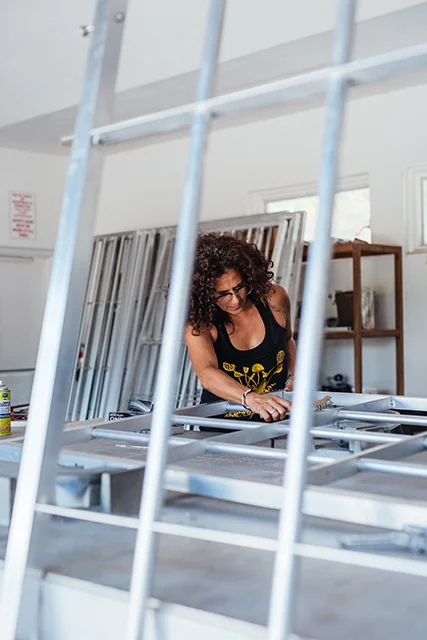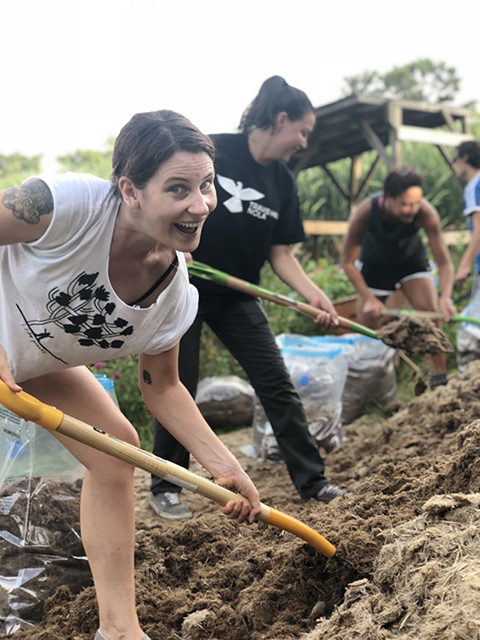About
About the Project:
“Jackie, in your letter you asked me: “What sort of house does a man who has lived in a 6’ x 9’ cell for over 30-years dream of?!”— In the front of the house I have 3-squares of gardens. The gardens are the easiest for me to imagine, and I can see they would be certain to be full of gardenias, carnations and tulips. This is of the utmost importance. I would like for guests to be able to smile and walk through flowers all year long.”
-- Herman Wallace, excerpt from a letter to jackie sumell, February 1, 2006
jackie sumell’s most celebrated project, Herman’s House, resulted from an incredible 12-year collaboration with political prisoner Herman Wallace. Herman spent over decades in solitary confinement in the State of Louisiana, for a crime he could not have possibly committed. In his 29th year of isolation, while a graduate student at Stanford University, she began writing him, eventually asking: “What kind of house does a man who has lived in a six-foot-by-nine-foot box for almost thirty years dream of?” This question launched our collaborative project, The House That Herman Built (Herman’s House), an ongoing exhibition, installation, book, advocacy campaign, and Emmy Award-winning documentary (Best Artistic Documentary, 2013). After spending over 41 years in a 6’ x9’ cage, Herman’s conviction was overturned and he was released from prison on October 1, 2013. He died 3-days later from the complications of advanced liver cancer. Fueled by the desire to keep Herman’s legacy alive, The Solitary Gardens, turns solitary confinement cells into garden beds that are the same size and blue-print as the cell Herman, and so many others spend decades in. The contents (plants, flowers and herbs) of the prison-cell-turned-garden-bed are designed by prisoners serving their sentences in isolation through proxies on the outside. Central to this project is a call to end the inhumane conditions of solitary confinement, simultanously inspiring compassion necessary to dismantle systems of punishment and control.
Slavery did not end, as is commonly believed, in 1865; it merely evolved. The 13th Amendment of the United States Constitution includes a strategic exception to the abolition of slavery for those “duly convicted of a crime.” Prisons in the United States are filled with people of color “duly convicted of a crime” at a rate almost eight times higher than whites. Thus, conversations surrounding prison abolition and radicalized capitalism are required in order to facilitate authentic possibilities for a non-racist, non-exploitative, non-hierarchical democratic order.
Of the 2.2 million incarcerated people in the United States, 80,000 to 100,000 are subjected to indefinite solitary confinement everyday. Prisoners are isolated for a minimum of twenty-three hours per day in a six-by-nine-foot (or smaller) concrete and steel cell. No judge or jury places an individual in solitary confinement; the decision is made solely by prison officials. The devastating, and often irreparable, effects of solitary confinement include, but are not limited to, alienation, dehumanization, despair, disorientation, paranoia, and suicidal ideation. Solitary confinement is torture and has been defined as such by the United Nations, the American Civil Liberties Union, and human rights watchdogs around the world. It remains one of the most concentrated forms of punishment in the United States, making anti-solitary work a paramount target for true abolition.
The Solitary Gardens, are constructed from the byproducts of sugarcane, cotton, tobacco and indigo- the largest chattel slave crops- which we grow on-site, exposing the illusion that slavery was abolished in the United States. The Solitary Gardens utilize the tools of prison abolition, permaculture, contemplative practices, and transformative justice to facilitate exchanges between persons subjected to solitary confinement and volunteer proxies on the “outside.” The beds are “gardened” by prisoners, known as Solitary Gardeners, through written exchanges, growing calendars and design templates. As the garden beds mature, the prison architecture is overpowered by plant life, proving that nature—like hope, love, and imagination—will ultimately triumph over the harm humans impose on ourselves and on the planet.
The Gardens are both a park in the Lower 9th Ward of New Orleans and several host garden sites across the country where volunteer individuals, groups, and nonprofits facilitate their own exchanges with those condemned to isolation in America’s prisons. The Solitary Gardens is a social sculpture and collaborative project that cultivates conversations around alternatives to incarceration by catalyzing compassion. This project directly and metaphorically asks us to imagine a landscape without prisons.

























































































































































































